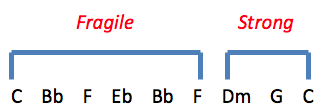Ever try playing a good chord progression backwards? It doesn’t always work, but it’s worth the time to experiment.
When you do something in songwriting the same way each time, it’s called using a formula, and it’s not usually the kind of thing a songwriter should be aspiring to do. But there is one exception, and it has to do with chord progressions. Many songs use similar, or even the same chord progressions, and as long as everything else — the rhythms, melodies, feel, lyrics, etc. — are different, you’ll be fine.
If you like looking through chord charts just to get some ideas for you next song, you may be missing out on lots of potential ideas if all you’re doing is playing through the progression and then deciding if you like it or not.
____________
 Are you practicing your songwriting, or just reinforcing the same mistakes?
Are you practicing your songwriting, or just reinforcing the same mistakes?
Gary Ewer’s “The Essential Secrets of Songwriting” shows you every aspect of what makes a great song great. Read more..
____________
I want to give you some ideas for other things you can do, and I want to use this progression as a model:
C Bb F Eb Bb F Dm G C
I did up a little sound file using one of UJAM‘s online templates, just to give you an idea of what this progression sounds like: LISTEN.
First, you’ll notice that though it starts on C, it moves quickly away from the typical chords you’d expect in that key, and it takes you on a bit of a harmonic journey into Bb major. But by the time you hear that Dm chord near the end, it’s all pulling back into the first key of C major.
In that sense, we might call the first half of this progression fragile and the second half strong:
The term fragile simply means that it ambiguously moves away from the established key (C major), while the term strong refers to the fact that it strongly pulls the listener back into C major.
So, some quick ideas for what you can do with a progression like this:
- Back-and-forth. Don’t feel you can only use the progression as is. Try moving back and forth from one chord to another before moving on again. Example: C Bb C Bb C Bb C Bb /F Eb F Eb…)
- Start in the middle. You can get some great ideas by starting in the middle of the progression, and then perhaps starting at the beginning. If you do that with this chord example, you can give the interesting impression of being in F major, and then switching to C major. Example: Bb F Bb F Bb F Bb F /C Bb F…
- Play it in reverse. Not all progressions will sound good when you play them in reverse, but it’s always worth a try. Example: In this case, the progression has a certain charm when you play it in reverse: C G Dm F /Bb Eb F Bb/ C
- Add pedal point. Pedal point means that you keep the same note in the bass while the chords change above it. The most common choice is typically holding the tonic note (C, in this case), or holding the dominant (5th) note (G). Example: With a tonic pedal, you’ll get these chords (the note after the slash indicates the bass note): C Bb/C F/C Eb/C Bb/C F/C Dm/C G/C C.
- Choose different starting points. We’re always tempted to start at the beginning of a progression and play through to the end, but here’s a thought: if an entire progression works, it will also work if you start partway through and then play to the end. Example: You could try this: Start with the last 2 chords: G C. Then try jumping back and playing the final 4 chords: F Dm G C. Then perhaps the last 2 again: G C. Then jump back and start on the Eb… you get the idea. In other words, if you’ve got 1 chord progression that’s 8 chords long, it will give you lots and lots of other potential progressions to experiment with.
__________
 Written by Gary Ewer. Follow Gary on Twitter.
Written by Gary Ewer. Follow Gary on Twitter.
“The Essential Secrets of Songwriting” eBook Bundle packages look at songwriting from every angle, and have been used by thousands of songwriters. How to use chords, write melodies, and craft winning lyrics. Get the bundle deal (Deluxe Bundle) Read more..












Pingback: 88 key weighted keyboard - House and Working Out
Yet another great blow from you Gary 🙂 Was having a few troubles with the notes, but now resolved…….
Tritone substitution, maybe?
Thanks again Gary. A quickie? How does that “A” note work with the E flat chord on your demo? Is it because it’s distantly related through the Am key?
Hi Brian and Mey – Well, it’s hard to say why it works, and Mey, It think you’re on the right track thinking of it as a tritone substitution, though not of the original key. The way I hear it, the A gets added to the Eb chord and makes it sound like it wants to move down to a D chord. If you play the chords F Eb+11 D, you’ll hear that the A acts as what’s called an inverted pedal. Except in this case, the Eb+11 is followed by Bb.
-Gary
Thanks for the replies guys!! My comment sort of follows on from my previous comment about melody and getting lost over “expensive progressions”. Whatever the mechanics, it’s a nice dissonance. And of course E flat flat 5 is an “A” note. Gary, a lot of song melodies begin from the tonic’s third, could we use the same progression starting there?
Thanks Gary 🙂 so the A note was added to make the chord progression smoother by using a “common tone” 🙂